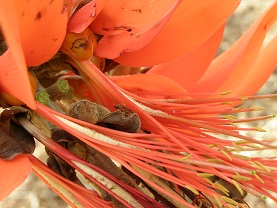Erythrina schliebenii is a Critically Endangered tree species, endemic to Tanzania in East Africa. The tree belongs to the genus of ‘coral trees’ which have beautiful red flowers and spiny trunks. Erythrina schliebenii was thought to have gone Extinct, but was rediscovered and conservation measures are now in place. Population numbers are extremely low and conservation measures, in situ and ex situ, remain a priority to ensure the survival of this charismatic tree species.
The tree was first discovered and collected in the 1930s, in an area of forest on the sides of Lake Lutamba, in southern coastal Tanzania. The area was cleared for a cashew nut plantation and following unsuccessful searches for the species it was declared Extinct in The World List of Threatened Trees (Oldfield, et al., 1998).
In 2001 specimens with flowers of this species were collected from Namatimbli, a small patch of unprotected forest 115km from the original collection locality by Frank Mbago of the University of Dar es Salaam Herbarium. The flowers were sent to the Royal Botanic Gardens Kew for verification and were confirmed to be Erythrina schliebenii.
In 2011 botanists from Tanzania’s University of Dar es Salaam returned to Namatimbili and collected specimens of E. schliebenii with both flowers and fruit. The single known locality only has a population of around 12 mature individuals and the area is under severe threat from degradation and clearing due to improvements in infrastructure and rapid population increase. This has led to the species’ current status on the IUCN Red List as Critically Endangered.
Propagation material of E. schliebenii was collected and five healthy seedlings have been successfully cultivated by Head Gardener at the State House in Dar es Salaam, Mr.Lenin Festo. One seedling was ceremonially planted in the grounds of State House and in Zanzibar on Union Day in 2014 (26th April), to mark the 50th anniversary of the unification of Tanganyika and Zanzibar to form the United Republic of Tanzania. This event coincided with Arbor Day and was an occasion to celebrate the valuable conservation efforts of such an attractive species. Find out more about the Union Day tree planting event.

Erythrina schliebenii - pod, seeds and spiny trunk
Did you know?
During World War II, most of the specimens from the first collection of Erythrina schliebenii were destroyed when the Berlin Herbarium caught fire during a bombing raid.
